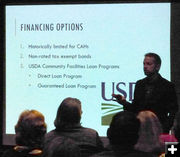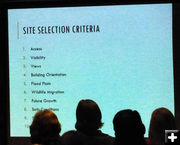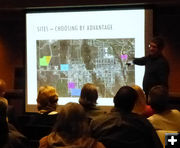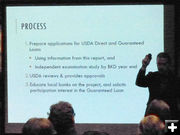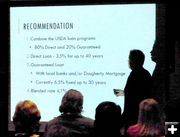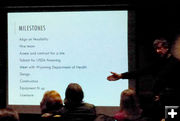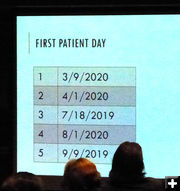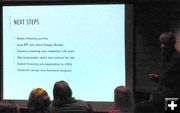Rural Health Care District board continues to move forward with Critical Access Hospital
Could be operational by 2020
by Dawn Ballou, Pinedale Online!
Original post October 4, 2017 | Updated October 9, 2017
The Sublette County Rural Health Care District (SCRHCD) held a Special Meeting at the Marbleton Town Hall the evening of Monday, October 2nd. After an executive session, the board held a second Special Meeting open to the public to hear a Final Report by consultants Michael Curtis of the Neenan Company, Charles Ervin & Brian Haapla of Dougherty Mortgage, and Ann King White of BKD. This consultant group was hired by the District and St. Johnís Medical Center to do a financial analysis and strategic planning of the Districtís plan to build a hospital separate from the current clinic facilities.
The Report confirmed that a sustainable Critical Access Hospital can be built in Sublette County and provided the basis for that statement as well as recommended service lines, departments, sizing and related criteria for such a hospital.
The SCRHCD board voted to move toward a CAH in Sublette County in January 2016 with the results of the Eide-Bailly report. It was reconfirmed in January 2017 with a Statement of Position approved by the SCRHCD Board. This study was a next step in determining what that hospital will look like.
St. Johnís Medical Center in Jackson, Wyoming has offered to provide whatever management services and assistant that SCRHCD feels it needs as the District moves toward the CAH.
Prior to this meeting and as part of their study, the consultants facilitated a 3-day strategic planning session on their goal of a Critical Access Hospital (CAH) in Sublette County and invited the public to give input. Between 42-48 people attended the workshops on those days to take a close look at the health care challenges facing the county. The consultants used the results of those sessions, as well as analysis of previous paid consultant studies and reports, to come to conclusions about the needs and desires of the Sublette County community.
Consultant Michael Curtis does health care business development for Neenan, a health care development company out of Colorado. They do design/build and real estate development deliveries of new and renovated hospitals, medical clinics and commercial build-to-suits. His focus is on rural hospitals and physician groups. Dougherty Mortgage is a financial company that specializes in federal agency loan programs and helps health care facilities get the financing they need to operate and expand. Charles Ervin and Brian Haapla work for Dougherty Mortgage specializing in helping rural communities renovate and develop health care facilities for their needs. BKD is a CPA and advisory firm that consults nation-wide and internationally. Ms. White has experience consulting with hospitals, physicians groups, and rural health care clinics on their financial operations.
Michael Curtis of The Neenan Co, said, "Your community can sustain a Critical Access Hospital." The challenge is finding a mechanism where the SCRHCD can be reimbursed for the services they provide. Presently, because they are considered medical clinics and do not have hospital status, the way the laws are written they are not reimbursed by Medicare for many of the services they provide so they are losing money on their operations. The consultants agreed that the current health care district is built on an unsustainable model and they have insufficient revenue from their operations to cover their costs. Curtis said that tax revenues have allowed Sublette County to have health care services beyond what can be supported by their population base with the current model of services. Their analyses concludes these lost revenues could be recouped with a CAH, giving better medical care services for the people of Sublette County.
The goal of the SCRHCD is to have quality medical services within a 30-minute drive time of anywhere in the county, citing the "golden hour" of critical health care situations. In emergency medicine, the golden hour (also known as golden time) refers to a time period lasting for one hour, or less, following traumatic injury being sustained by a casualty or medical emergency, during which there is the highest likelihood that prompt medical treatment will prevent death.
Brian Haapla spoke of creating a "hub and spoke" type of service with a CAH in Pinedale and a satellite clinic in Marbleton/Big Piney. Under a CAH, the Health Care District would be able to bill out all of their service costs at the Marbleton Clinic, which they currently cannot do. Haapla said a the goal of the county health care system would be to try to capture more of the health care services residents are currently going out of county for and to become the health care provider of choice for local residents. Their analysis indicates the local needs of the CAH are for about 8 beds, two to three for acute care patients and three to five beds for swing care patients needing only a few days of temporary care. The new hospital could gain revenue by having after-hours emergency services, x-ray exams, CAT scans, radiology equipment, and additional lab testing in a hospital setting instead of the current clinic setting, Haapla said.
Ann King White said under the current scenario the SCRHCD is not getting payment for a lot of the services they are providing. "Youíre not getting a lot of money for all the care you are giving." She expected the district could recoup about $4 million in net revenue by becoming a CAH even without any added service lines.
The conclusion of the consultants was that Sublette County and the SCRHCD could sustain a Critical Access Hospital. They estimated the facility needed would be around 35,000 square feet and would cost $450 to $480 per square foot to build, for a total of around $25 to $30 million construction cost. They encouraged to Board to raise as much of the construction money as they can through donations to lower the amount that would be needed for long-term loans. The USDA has a Community Facilities Loan Program that might be a source for funding, although the consultants acknowledged the USDA hasnít done any health care projects yet in Wyoming. They said the county could have a building in place and up and running by 2019 or 2020 if all goes well.
SCRHCD Chairman Laura Clark said that if the hospital was sustainable on its own, they wouldnít be asking for a mill levy increase from taxpayers. "It will be self-sustaining," she said, "if we can get this thing up and get it going."
The board plans on building a new hospital facility rather than renovate the current Pinedale Medical Clinic. It has not been decided what the plan would be for the current Pinedale Clinic building, which is less than 10 years old and is owned by the County. It was built in 2008 and is already apparently outdated according to pending new regulations regarding emergency room standards and would require approximately $500,000 to bring it up to the expected new regulations. It was not clear if the funding obtained to build the CAH includes the $500,000 that will be needed to upgrade the Marbleton Clinic ER to bring it up to standards by June 2019 so it can continue to be used.
As to where might the new hospital be located, several possible sites were shown on a map including in the Bloomfield subdivision west of town, open space between the Wyoming Highway Department and High Country Suites, and lots south of the Sublette County Ice Arena.
After the consultantsí presentation, there was a question and answer period from the audience. One person asked how taking away the swing beds would impact the Sublette Center in Pinedale? The response was they felt the CAH would "enhance" their operations. Sublette Center would continue to provide rehab care and the hospital would capture other people who are currently going out-of-county to swing facilities that offer more advanced medical services than what is available at the Sublette Center.
It was asked what is St. Johnís offering with the CAH? Dr. Paul Beaupre, CEO for St. Johnís Medical Center in Jackson, said they would assist with the project. "We believe strongly you need a sustainable form of health care here," he said. They can help with staffing, visiting physicians, anesthesia, surgery and radiology. They would bring expertise on how to run a CAH. The current clinics would then become urgent care clinics.
Dr. David Kappenman, Medical Director of the Pinedale Clinic, said St. Johnís is offering "a la carte" administration. "We can use them as a fee for service. What St. Johnís is offering is management not governance. To have them step up and help us is huge," he said.
Another question from the audience was "who makes the decision?" The decision and financing is entirely with the Rural Health Care District board, Laura Clark said. Sublette County would not be involved in the financing. Sublette County Commissioners Dr. David Burnett and Mack Rawhouser in attendance indicated the position of the commissioners was that the financing and operations of this project were the responsibility of the SCRHCD board with their health care mill levy tax and other revenue sources, but the commissioners were not opposed to the idea of having a CAH in the county.
The $25-$30 million price tag estimate doesnít cover the whole story of this obligation for the SCRHCD and Sublette County taxpayers. It was pointed out that over the life of the 40-year loan, that when the interest to be paid on a loan is added in, the total cost of the CAH could be $60+ million. (Loan providers stand to make up to $30+ million in interest over the lifetime of the loan.) It was also pointed out that there is no early payment penalty so the interest could be far less if the CAH is financially successful and can pay off the loan early. This doesnít take into consideration additional funds that might be needed in the future for repairs or to upgrade the facilities over four decades to stay in compliance with federal regulations for hospital standards.
Neither the consultants or board members gave an estimate of what might be the cost increases in annual operating expenses of the CAH for the Rural Health Care District compared to the current clinics or for equipment and furnishings. There also were no estimates given of the increases that are projected to be needed for medical and administration personnel to staff expansion for the new CAH, who would be added to the Sublette County government payroll.
The next steps are to put together a CAH team, select and secure a site, secure federal and private loan financing, work with the Wyoming Department of Health, get as much local financial support as possible, do the design and construction, and get the equipment and licensing.
For more information go to www.sublettehealthcare.com
|

